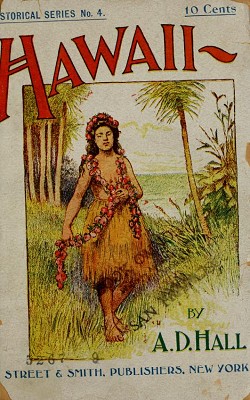
a. d. hall : surf riding at waikiki, 1898
| home | catalogue | history | references | appendix |
 |
surfresearch.com.au
a. d. hall : surf riding at waikiki, 1898 |
Open
Library
http://openlibrary.org/books/OL23303005M/Hawaii
Nearly
every afternoon
the drives about Honolulu are thronged with brilliant
equestrians.
All classes
and
conditions swim as well as they ride.
The climate
is
so warm it makes the bathing perfection.
Beautiful
convolvulus
fringe the shore, and make a pretty background for the
bathers.
In the surf
they
perform all sorts of feats, and particularly one worthy of
mention is that
of riding the waves by the use of the surf board.
The surf
board
is a plank resembling a coffin lid, measuring about six feet
nine inches
in length.
After wading
out from the rocks, upon which the surf is breaking, the
islanders push
their board in front of them, and swam
out beyond
the
first line of breakers.
Watching for
a very high wave, they will leap out from behind, lying
Page 44
with their
bodies
face downward upon their surf boards.
The swimmers
keep themselves on the highest edge of the billow, and by
dexterously manipulating
hand and foot ever seem to slide down the topping wave.
On they
come,
a little ahead of the breaker, and just as you would expect
to see them
dashed to pieces against the rocks, they quietly vanish, and
are out at
sea, ready for another perilous ride.
The great
art
attached to this aquatic feat is in mounting the breaker
just at the proper
time, and to keep exactly in its curl.
Old men and
young
girls often join in this amusement, and are wildly cheered
by the spectators.
Very often
when
luncheons are given, and the guests have assembledd, the
question is asked
: "Will you have a swim ?"
This is
nearly
always answered in the affirmative, and the guests go to
rooms, adorn themselves
in bathing suits which are provided for them, and take a
swim before luncheon
is announced.
Men and
women
bathe together after our American fashion, and there is no
such prudery
regarding this custom as is shown by
our English
cousins.
Another
favorite
form of amusement is riding out on a moolight night to
Waikiki, having
a swim, a jolly supper, and arriving home in the " wee small
hours."
An American
gentleman
and his wife occupying a villa at Waikiki gave a ball to the
officers of
H. M. S. Garnet, and to the officers on board the American
cruisers.
They danced
until
midnight, when they all departed to rooms assigned them, and
changed their
festive gowns and uniforms for
bathing
dresses.
It was a
beautiful
sight, with a full moon,
Page 45
and they
swam
instead of dancing to the strains of the music.
When they
tired
of this they once more adorned themselves in their ballroom
attire, and
danced till morning.
 |
Hawaii Historical series, no. 4. Street & Smith, New York, 1898. Open
Library
|
 |

| home | catalogue | history | references | appendix |